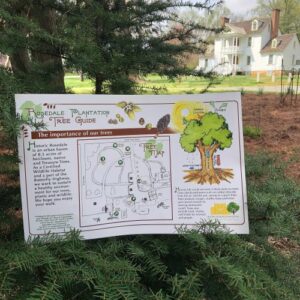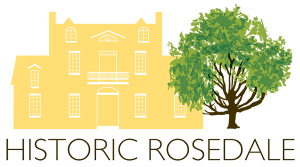A Jewel in the Queen City’s Crown :
Part One: Treasure Trees
Historic Rosedale presents a triple treat in the city of Charlotte; a historic home, a big tree museum, and lovely gardens on nine acres. This month we shine the spotlight on our big tree museum with its numerous Treasure Trees. Recently, the data on these very special trees was updated by Trees of Charlotte with the help of Heartwood Tree Service.
In the 1980s a group of Charlotte citizens became interested in recording data on unique trees in Mecklenburg County. Each tree was recognized, recorded in a database, and tagged for one or all of these criteria: size, age and/or an unusual species for the area. Hence, the Treasure Tree program was developed and 123 trees were tagged and prized. Trees Charlotte, a nonprofit collaboration, has taken the reins on caring for and adding to Charlotte’s tree canopy. They recently updated the data on Rosedale’s Treasure Trees and attached new tags with barcodes.
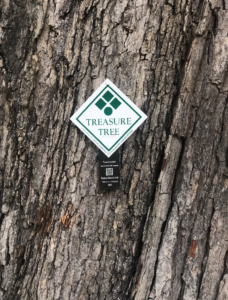

Trees Charlotte has developed tour maps of the Treasure Trees throughout Mecklenburg County and Tour Number 5 focuses on Rosedale. Historic Rosedale’s big tree museum is fortunate to have five Treasure Trees on the property. Our Treasure Trees are each unique in their own right and as a collection are a rare treat. They are a conglomeration of specimens from throughout our history. Members of the Frew, Caldwell, and Davidson families nourished these and other trees onsite from as early as 1815 and continuing well into the 1980s.
The original Firmiana simplex, commonly known as the CHINESE PARASOL TREE, was planted in the 1950s from seed by Louise Heagy Davidson, wife of Craighead Davidson. Louise’s daughter Mary Louise remembers her mother gathering the seeds from the old Burton Smith property which once stood at 700 North Tryon Street. This exotic species is originally from Asia where the wood was used for instrumental soundboards. The North Carolina Forest Service named our tree the state champion, the biggest of its kind in the state, at over 59 feet tall.
Almost directly in the middle of Rosedale’s nine acres stands a grand GREEN ASH TREE, Fraxinus pennsylvanica. The Ash was a popular shade tree due to its rapid yearly growth. Rosedale’s Ash has exceeded the average 60-foot height as it now stands at over 85 feet tall. Historically, Ash wood was used for making oars. Today, Ash wood is used exclusively for Louisville Slugger baseball bats.
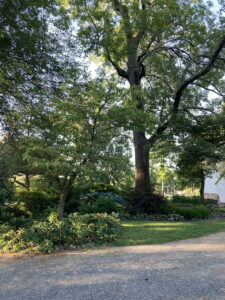
Under the shade of the Ash tree stands the surviving sapling from the original SASSAFRAS TREASURE TREE, Sassafras albidium. The original tree was struck by lightning sometime in the 1980s, but this devastation has not hindered the original progeny’s growth. All parts of the Sassafras tree are edible and have been used medicinally for lowering high temperature and originally Sassafras was the main ingredient in root beer.
The SWAMP CHESTNUT OAK, Quercus michauxii, is Rosedale’s grandest Treasure Tree. It is an unusual species for this location. As the name suggests, this species is known to grow in bottomlands and wetland where moisture is a mainstay. In 1894, this tree was brought to the site in a sack, as a gift to Robert Baxter Caldwell. For many years, this tree was the shade tree for the paddock; hogs and cows feasted on the nuts dropped by the tree and horses were allowed to rest there before being place in their stalls. Today, at over 84 feet tall, this tree will absorb about 1,966 pounds of CO2 from the atmosphere each year.
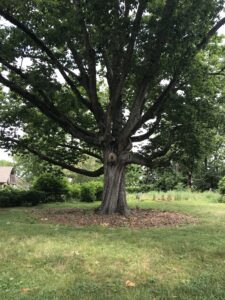
The relics of an OSAGE ORANGE grove, Maclura pomifera, can be found at Rosedale. The grove caught fire when one of the nearby barns burned in the 1960s. Due to its very dense wood, the charred trees miraculously sprouted back from the ground, continuing their 160-year-old heritage. In 1857, Robert Baxter Caldwell brought these trees from Florida to plant as a hedgerow, a prickly living fence commonly used before the invention of barbed wire.
Our ORIENTAL ARBORVITAE, is located in the formal gardens. Louise Heagy Davidson used this beautiful tree as the focal point of her garden design, dividing her “little garden” from the “main garden”. As an Asian evergreen conifer, the Arborvitae is slow growing with the average height of 20 to 25 feet and average spread of 12 to 15 feet. The Rosedale conifer is 35 feet tall with a 21-foot spread. It is believed that this treasure of a specimen dates back to the construction of the Rosedale house by original owner Archibald Frew in 1815.
Taking in the splendor of this Treasure Tree collection is easy. Visit Historic Rosedale! Pick up a copy of our Big Tree Museum guide and get lost in an urban green space located just minutes from Uptown Charlotte. Close your eyes. Breathe deeply. Relax, you’ve earned the opportunity to experience this Jewel in the Crown of the Queen City.
